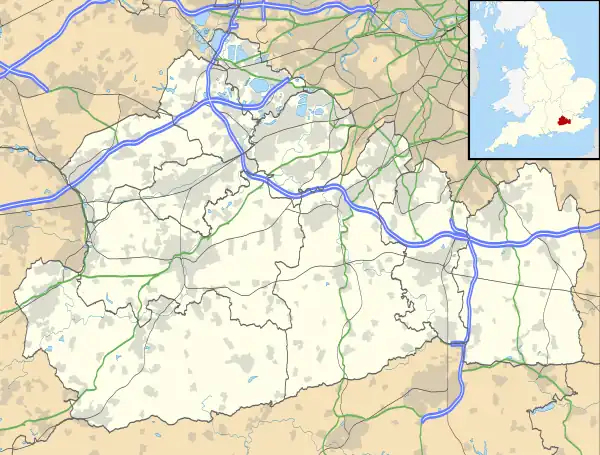Woodhouse Copse, Holmbury St Mary
Woodhouse Copse is an Arts and Crafts style house in the village of Holmbury St Mary, Surrey, England. It is a Grade II listed building,[1] with gardens originally planted by garden designer Gertrude Jekyll. Country house opera is performed by Woodhouse Opera at the annual Woodhouse Summer Opera Festival.
| Woodhouse Copse | |
|---|---|
 Location of Woodhouse Copse in Surrey | |
| Location | Holmbury St Mary |
| Coordinates | 51°11′45″N 0°24′51″W |
| OS grid reference | TQ1079445320 |
| Area | Surrey |
| Built | 1926 |
| Architect | Oliver Hill |
| Architectural style(s) | Arts and Crafts |
| Owner | Monika Saunders |
Listed Building – Grade II | |
| Official name | Woodhouse Copse |
| Designated | 4 August 1997 |
| Reference no. | 1245123 |
House
Built in 1926, the house was designed by architect Oliver Hill for the stage and film actor Amy Brandon Thomas and her husband William Deane Barnes-Brand.[1] In 1939 Hill built another house for the couple, Burrows Wood in Gomshall, Surrey, which is also Grade II listed.[2]
Woodhouse Copse is a large cottage orné, originally with a thatched roof,[1] built in brick with weatherboarding and a large, central stone chimney. Hill was influenced by Edwin Lutyens and Gertrude Jekyll in his use of local materials and vernacular architecture.[3] However, his almost sculptural shaping of the thatch was distinctive.[4] He built similar houses elsewhere in the 1920s, including at Croyde, Devon and Knowle in the Midlands. Woodhouse Copse also featured timbers retrieved from an old mill at Coulsdon, as commemorated in a verse engraved in 1925 on a window.[3] The central shaft from the mill was incorporated into a spiral staircase. The house's thatch was later removed.[1]
Garden
Hill laid out the garden with its terraces, drystone walls and circular steps. Over 1926–28, Jekyll drew up planting plans for the flowerbeds, and supplied the plants from her nursery at Munstead Wood, Surrey,[5] where Amy Brandon Thomas was a frequent visitor.[6]
Music
Musical performances are organised by Music at Woodhouse,[7] which is led by Monika Saunders, the house's owner. She converted an indoor swimming pool into a concert room and created a lakeside amphitheatre for opera. [8] Besides the annual opera festival, concerts are held throughout the year. There is a focus on using young performers,[9] including some drawn from the Royal College of Music and the Royal Academy of Music.[7]
See also
- List of opera festivals
- Joldwynds, Holmbury St Mary (Oliver Hill, 1932)
References
- Historic England. "Woodhouse Copse (1245123)". National Heritage List for England. Retrieved 1 August 2013.
- Historic England. "Burrows Wood (1391775)". National Heritage List for England. Retrieved 1 August 2013.
- Vanden Berghe, Vanessa (2013). "Oliver Hill: A Window on Regionalism in Britain during the Interwar Period". In Meganck, Leen; Van Santvoort, Linda; De Maeyer, Jan (eds.). Regionalism and Modernity: Architecture in Western Europe 1914–1940. Leuven: Leuven University Press. pp. 185–187. ISBN 978-90-5867-918-5.
- Richardson, Margaret (1983). Architects of the Arts and Crafts Movement. London: Trefoil Books. p. 139. ISBN 0-86294-031-1.
- Tankard, Judith B. (2011). Gertrude Jekyll and the Country House Garden. London: Aurum Press. p. 170. ISBN 978-1-84513-624-6.
- Massingham, Betty (1966). Miss Jekyll: Portrait of a Great Gardener. London: Country Life. p. 98.
- Kimberley, Nick (19 May 2010). "Best garden operas in London". London Evening Standard. Retrieved 1 August 2013.
- White, Michael (15 February 2011). "Is the private salon dead? Not quite". The Daily Telegraph. Archived from the original on 19 February 2011. Retrieved 1 August 2013.
- "A steely Pittsburgh performance". Catholic Herald. 16 September 2011. Retrieved 1 August 2013.